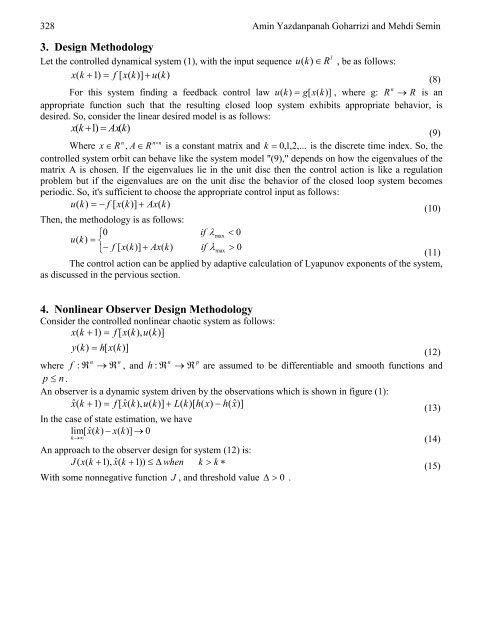European Journal of Scientific Research - EuroJournals
European Journal of Scientific Research - EuroJournals
European Journal of Scientific Research - EuroJournals
Create successful ePaper yourself
Turn your PDF publications into a flip-book with our unique Google optimized e-Paper software.
328 Amin Yazdanpanah Goharrizi and Mehdi Semin<br />
3. Design Methodology<br />
l<br />
Let the controlled dynamical system (1), with the input sequence u( k)<br />
∈ R , be as follows:<br />
x ( k + 1)<br />
= f [ x(<br />
k)]<br />
+ u(<br />
k)<br />
(8)<br />
For this system finding a feedback control law u ( k)<br />
= g[<br />
x(<br />
k)]<br />
, where g: R R<br />
n → is an<br />
appropriate function such that the resulting closed loop system exhibits appropriate behavior, is<br />
desired. So, consider the linear desired model is as follows:<br />
x ( k + 1)<br />
= Ax(<br />
k)<br />
(9)<br />
n<br />
n×<br />
n<br />
Where x ∈ R , A∈<br />
R is a constant matrix and k = 0,<br />
1,<br />
2,...<br />
is the discrete time index. So, the<br />
controlled system orbit can behave like the system model "(9)," depends on how the eigenvalues <strong>of</strong> the<br />
matrix A is chosen. If the eigenvalues lie in the unit disc then the control action is like a regulation<br />
problem but if the eigenvalues are on the unit disc the behavior <strong>of</strong> the closed loop system becomes<br />
periodic. So, it's sufficient to choose the appropriate control input as follows:<br />
u ( k)<br />
= − f [ x(<br />
k)]<br />
+ Ax(<br />
k)<br />
Then, the methodology is as follows:<br />
(10)<br />
⎧0<br />
u(<br />
k)<br />
= ⎨<br />
⎩−<br />
f [ x(<br />
k)]<br />
+ Ax(<br />
k)<br />
if λmax<br />
< 0<br />
if λmax<br />
> 0<br />
(11)<br />
The control action can be applied by adaptive calculation <strong>of</strong> Lyapunov exponents <strong>of</strong> the system,<br />
as discussed in the pervious section.<br />
4. Nonlinear Observer Design Methodology<br />
Consider the controlled nonlinear chaotic system as follows:<br />
x(<br />
k + 1)<br />
= f [ x(<br />
k),<br />
u(<br />
k)]<br />
y(<br />
k)<br />
= h[<br />
x(<br />
k)]<br />
(12)<br />
n<br />
where f : ℜ<br />
p ≤ n .<br />
n<br />
n<br />
→ ℜ , and h : ℜ<br />
p<br />
→ ℜ are assumed to be differentiable and smooth functions and<br />
An observer is a dynamic system driven by the observations which is shown in figure (1):<br />
xˆ ( k + 1)<br />
= f [ xˆ<br />
( k),<br />
u(<br />
k)]<br />
+ L(<br />
k)[<br />
h(<br />
x)<br />
− h(<br />
xˆ<br />
)]<br />
In the case <strong>of</strong> state estimation, we have<br />
(13)<br />
lim[ xˆ<br />
( k)<br />
− x(<br />
k)]<br />
→ 0<br />
k →∞<br />
An approach to the observer design for system (12) is:<br />
(14)<br />
J ( x(<br />
k + 1),<br />
xˆ<br />
( k + 1))<br />
≤ ∆ when k > k ∗<br />
(15)<br />
With some nonnegative function J , and threshold value ∆ > 0 .

















